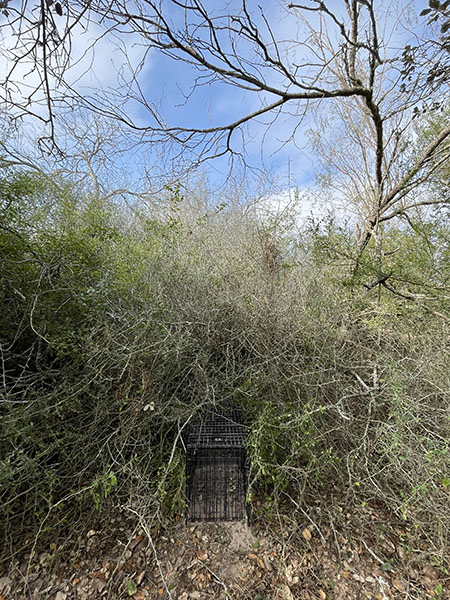
THIS IS A BOX TRAP SET in the tangled, thornscrub habitat preferred by ocelots for seclusion and protection from predators. The ocelot is barely visible inside the trap and was not injured during the trapping. Photo by Lisanne Petracca, Caesar Kleberg Wildlife Research Institute. (Photo by Lisanne Petracca of Texas A&M University – Kingsville)
by John Jefferson
As one who grieves when a news report announces another wildlife species has become extinct, I was saddened by the realization that the jaguarundi had been declared extinct some time ago.
I admired them as friends, although I only caught a fleeting glimpse of one that dashed across the road in front of me as I left the Chisos Mountains in the Big Bend one night. I didn’t know what it was, but I was fascinated by seeing a strange critter I didn’t know existed. When I reached home in the Pineywoods on the other side of Texas, I researched and discovered what it was. Years later my interest was buoyed by seeing on the Aransas National Wildlife Refuge visitors’ comment log that a jaguarundi had been spotted there.
Leading photo workshops on the refuge for eight years, I had hoped to see one; but never did. And now they’re gone.
Having written about ocelots in this column twice, I knew that this small, spotted, wild cat was endangered. Like the jaguarundi, I had only seen one ocelot. It was the most beautiful animal I had ever seen. It had been reported that ocelot populations only numbered in the eighties … and were declining.
The remaining few in the U.S. exist in the densest parts of several counties in lower South Texas. Good habitat exists for them on the 110,000-acre Laguna Atascosa National Wildlife Refuge near Harlingen. That area of thick, tangled brush is the largest tract of undeveloped habitat remaining in the Valley.
In an earlier column, I quoted Dr. Mike Tewes, Texas A&M – Kingsville’s Regents Professor and the nation’s authority on wild cat studies — saying some ocelots had succumbed to roadkill; others to coyote or bobcat depredation. Camera Trapping has enabled better data capture on these elusive master night stalkers.
Tewes has also said that earlier efforts at ocelot conservation had been unsuccessful; that recovery on private ranches could be the answer.
Landowners are sometimes reluctant to allow their land to be used for research. Past government action has understandably created an aura of concern. But trust can be enhanced by carefully drafted contracts protecting landowners’ rights.
Agreements between the Caesar Kleberg Institute, the Yturria Ranch, and the East Foundation’s El Sauz Ranch have added acreage of significant ocelot habitat.
“San Antonio Viejo Ranch is the first site where ocelots will be released in the future,” Dr. Lisanne Petracca, PhD., an assistant professor of carnivore ecology with the Kleberg Institute, told me. That ranch is also managed by the East Foundation. TPWD and other agencies have cooperated on this project.
This brings 89,600-acres of brushland habitat in Jim Hogg and Starr Counties that is removed from high-traffic roadways and storm surge area into ocelot conservation. Landowners participating in the agreements will be assured they can continue their land uses – ranching, agriculture, and energy development.
“Ranchers must be a major element … for ocelot conservation,” Tewes said, adding that translocating ocelots from northeastern Mexico is also necessary.
JJ




